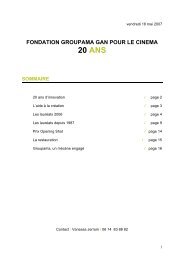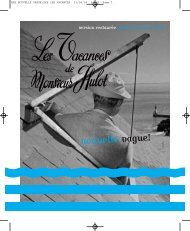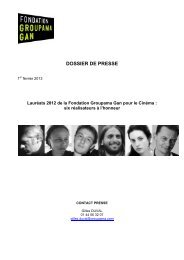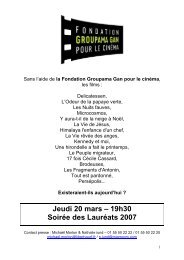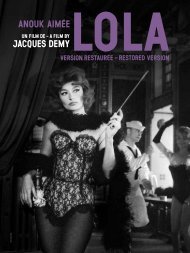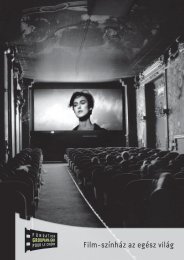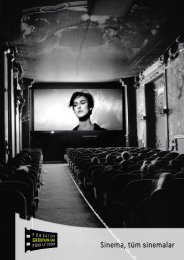duVoyage - Fondation Groupama Gan pour le Cinéma
duVoyage - Fondation Groupama Gan pour le Cinéma
duVoyage - Fondation Groupama Gan pour le Cinéma
You also want an ePaper? Increase the reach of your titles
YUMPU automatically turns print PDFs into web optimized ePapers that Google loves.
Méliès by Méliès, for the Dictionary of Illstrious Men,<br />
as yet unpublished…<br />
“[…] During the who<strong>le</strong> of this period of his life, Méliès was tortured by the demon<br />
of drawing and, even if his teachers gave him good grades, following his artistic<br />
passion earned him numerous punishments. His passion was stronger than him,<br />
and whi<strong>le</strong> he ruminated on a French dissertation or latin verses, his pen would<br />
mechanically begin to trace portraits or caricatures of his teachers or classmates,<br />
or else he would compose some fantasy palace or original landscape, which might<br />
already resemb<strong>le</strong> a theatrical décor. His notebooks and books were copiously illustrated.<br />
This was not to the taste of his school masters, and so saw him deprived of<br />
the right to venture outside the school on occasions too numerous to count (he was<br />
a boarder for 11 years). And that’s how, without a thought, vocations are hindered!<br />
But nothing worked in this case; Méliès continued to draw just as much, and would<br />
draw until his dying day.<br />
[…] When he finished his military service [November 1882], having always been<br />
first in drawing class, and having acquired some skill in painting during holidays,<br />
he went to Paris with the intention of entering the School of Fine Arts and to become<br />
an artist; but his father, an important industrialist, would not hear of it and formally<br />
opposed his son’s plans, declaring that by taking up such a profession one would<br />
only die of hunger. Against his will, therefore, he entered his father’s business.<br />
[…] During this period of his life [1889-1890], he was a journalist and illustrator,<br />
working under the anagramme of “Geo Smi<strong>le</strong>” (Georges Smi<strong>le</strong> in English) for the satirical<br />
journal, “La Griffe” (“The Claw”), an enemy of the famous General Boulanger<br />
who almost succeeded in overthrowing the French Republic and establishing a dictatorship<br />
in France.”<br />
«The life and work of one of the longest-standing pioneers of worldwide cinematography,<br />
Georges Méliès, creator of the cinematographic show” – text by Georges Méliès, written in the third person<br />
in 1936 for a Dictionary of Illustrious Men, a work which was never published.<br />
In London, magic rather than business<br />
In London, Georges Méliès sold shoes, then continued his business apprenticeship in a corset shop. But his stay<br />
in London was decisive, because it was there that he discovered the world of magic. He visited the Egyptian<br />
Hall of Maskelyne and Cook assiduously, a theatre dedicated to magic and illusion. It was in this theatre that<br />
John Nevil Maskelyne, one of England’s most famous magicians, initiated him to illusionism. Maskelyne had<br />
opened up the world of magic to new possibilities, presenting his tricks as a succession of short scenes. David<br />
Devant and Joseph Buatier de Kolta were two other magicians who would influence Méliès. David Devant<br />
taught Méliès his tricks and invited him onto the stage. As for Buatier de Kolta, Georges Méliès discovered his<br />
most admired illusion, “The Vanishing Lady”, the most imitated stage exploit of the 1880s and would use it later<br />
in his work. This illusion, which consists in making a woman in a chair disappear, would be Méliès’ most famous<br />
at the Robert-Houdin theatre. Transposed onto film in 1896 (The Capturing of a Lady), it became a cinematic<br />
reference: for the first time Méliès created a special effect by stopping the camera and modifying the objects<br />
being filmed.<br />
« And that’s how, born to an important industrialist, a luxury shoe<br />
manufacturer, I became a man of the theatre and founder of a family<br />
of artists. All because my father, thinking nothing could be better<br />
than his own profession, so fiercely opposed my entry to the School<br />
of Fine Arts...had that not been the case, it’s likely my career would<br />
have been devoted exclusively to painting.»<br />
Extract from a <strong>le</strong>tter from Georges Méliès to Paul Gilson, dated 16 th August 1929, as part of correspondance<br />
between the two in preparation for the Gala Méliès of 16 th December 1929 – Méliès Foundation – French Cinematheque<br />
One of David Devant’s most famous illusions was “The Artist’s Dream”, in which the life-sized portrait of a<br />
woman was brought to life in three dimensions in front of an amazed audience. In Le Portrait Spirite (1903),<br />
Méliès recreates this same illusion by substituting a painted canvas with a young woman.<br />
Return to Paris and settling down<br />
Méliès <strong>le</strong>ft London and returned to Paris in December 1884. He was 23 years old. On 29 th June 1885, he married<br />
Eugénie Genin (1867-1913), an orphan, rich heiress and accomplished pianist. They would have two children:<br />
Georgette in 1888 and André, born in 1901.<br />
Méliès joined the accounting department of his father’s business, but he was above all passionate about repairing<br />
the machines in the Méliès shoe factory situated 3-5 rue Taylor in Paris. Shortly after his return to<br />
Paris, he made the acquaintance of Voisin, a sel<strong>le</strong>r of automated machines, and a magician. The latter hosted<br />
sessions at the Grévin Museum, which opened in 1882, where large numbers of peop<strong>le</strong> showed their inventions<br />
and their ta<strong>le</strong>nts. Méliès perfected his magic skills and put on a show at the Cabinet Fantastique of the<br />
Grévin Museum in March 1886. He was subsequently hired by the Ga<strong>le</strong>rie Vivienne magic theatre. During this<br />
period, Georges Méliès also studied photography, and above all, extended his network of acquaintances in the<br />
world of theatre and show. It was Voisin who first mentioned the Robert–Houdin Theatre to him, and encouraged<br />
him to buy it.<br />
In 1888, Georges Méliès’ father, Louis, stepped down as head of the family business and Georges seized the opportunity<br />
to <strong>le</strong>ave the business. He sold his stake to his brothers in exchange for his share in the inheritance<br />
which consisted of 500,000 francs (approximately 1.5 million euros today) and a large house in Montreuilsous-Bois.<br />
78 79






